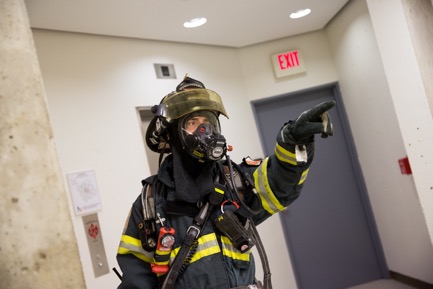EVANSTON - Northwestern University and the City of Evanston recently completed three days of emergency response drills designed to ensure the safety of research done on campus.
The exercises, which ran Aug. 22-24, involved simulated medical and hazardous materials incidents that could occur in research laboratories.
The site of these exercises this year was in and around the Hogan Building in the heart of the Science Center Complex.
Northwestern’s Department of Safety & Security, as well as the University’s Office for Research Safety (ORS), spent several months working with the Evanston Fire Department and the Northshore Regional Hazardous Materials Team of MABAS Division 3 (The Mutual Aid Box Alarm System) to plan, organize and conduct a different scenario on each day.
All of the 17 communities that are part of the MABAS Division 3 were represented in the drills.
“Through this outstanding collaboration, we once again met our primary objective to prepare first responders and NU ORS staff experts to handle these extremely high risk events,” said Brian R. Scott, chief of the Evanston Fire Department.
“These hands-on exercises focused on current best mitigation and emergency medical practices as well as disciplined resource allocation and communication that help us better prepare to save lives in these highly complex and dangerous environments that the Evanston Fire Department faces all too often,” Scott said.
This year, each day focused on a different primary hazard — be it biological, chemical or radiological. ORS carefully designs each scenario without revealing it in advance to the other participants. This keeps each scenario realistic, measurable and efficient.
“The purpose in designing each exercise is to test our collective ability to respond to an unknown situation, find where we need improvement and then use these experiences to get better,” said Michael Blayney, executive director for research safety at Northwestern.
The drills emphasize cross-agency collaboration.
“Last month’s emergency response drills provided an excellent opportunity for first responders from multiple agencies and disciplines to work on situational awareness, communication and incident command," Gregory said. "This type of training enhances life safety at Northwestern and is an invaluable learning experience for our local first responders from the Evanston Fire Department and NUPD,” said Gregory Klaiber, director of emergency management at Northwestern.
Remembering Commander Shaun J. Johnson
The various teams that took part in this year’s emergency response drills dedicated their efforts to the memory of the late Northwestern Police Commander Shaun J. Johnson.
Commander Johnson played a crucial role in the 2015 and 2016 drills. He was a leader in advancing Northwestern’s emergency preparedness program during his tenure as commander of emergency services.
He passed away Aug. 9.


